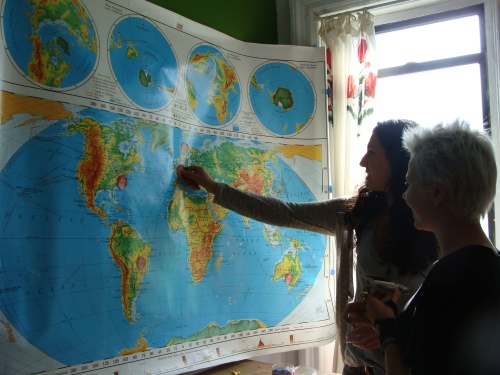As some of you may already know, I’ve spent the last few weeks working on Sweden.Closettour, a new site about sustainability and style, inspired by four days of reporting in Stockholm. It’s an alpha version of the sort of stories I plan to produce in the future–like a little swatch of material, presented in a slightly different format than you’ll find here at the blog. Like all the stories and posts from Closettour, its purpose is to put the “wonder” in wondering what to wear.
 Erin Dixon wonders what to wear at the Scandinavia House
Erin Dixon wonders what to wear at the Scandinavia House
It all began, as you’ll see in the video below, when an invitation arrived from the Swedish Institute, to meet the curators and designers behind EcoChic, a new exhibit opening this week at New York’s Scandinavia House.
The subject of sustainability, in the worlds of fashion and journalism alike these days, wears a cloak of mystery. Sweden.Closettour is an experiment in discovering sustainable models in both fields. For the time being, my work is funded by a grant for entrepreneurial journalism from the McCormick Foundation–and this trip had a little help from the Swedes. (See “The Trip” for details).
Kajsa Guterstam kept us caffeinated and on course in Stockholm
Along the way, I talked with fashion designers and physicists, farmers and factory managers, all of whom shared excellent insight. But the truest one came from Mathilda Tham, a brainy beauty who teaches design in Stockholm and London.
“You can’t be sustainable or holistic on your own,” she said, at the end of our meeting in March. “You’ve got to do it with other people.”
 Julie Miller and Lina Plioplyte stick my face on the map
Julie Miller and Lina Plioplyte stick my face on the map
I’ve joked these past few weeks, working long hours on a website about sustainable fashion, that my lifestyle has become less sustainable, and decidedly less fashionable. But, as Mathilda foreshadowed, the project wouldn’t have been possible at all without other people pitching in.
 Michael Lanzano shoots fruit and candy for the H&M story
Michael Lanzano shoots fruit and candy for the H&M story
Everyone whose name appears on that About page had a vital hand in getting the website up, and some of them were perfect strangers a few weeks ago. In the end, Grace Koerber helped weave it all together beautifully for the web (if I do say so myself), and the whole project would probably still be an elegant poster-board if Indrani Datta hadn’t helped whip it into shape.

Indrani Datta erases Sweden.Closettour’s to-do list
So, I’ve learned a lot about sustainability (and style), much of which you’ll find on Sweden.Closettour. I hope you find the clothes and characters there as compelling as I did, and that you’ll collaborate too, by sharing criticisms, questions and ideas on the comments page.
Thanks for your contributions so far. I hope this is just the beginning of the conversation that can sustain itself for a long time to come.








